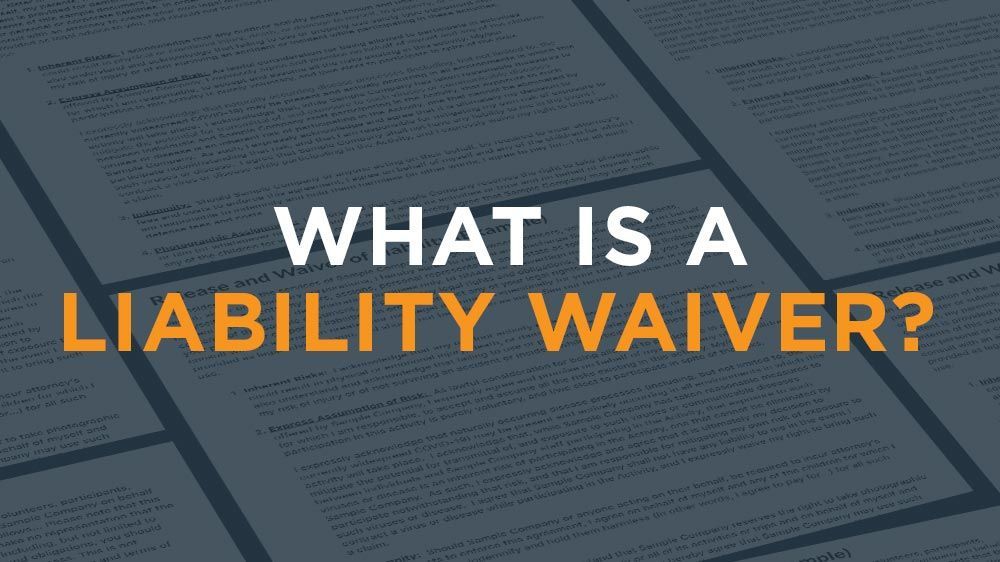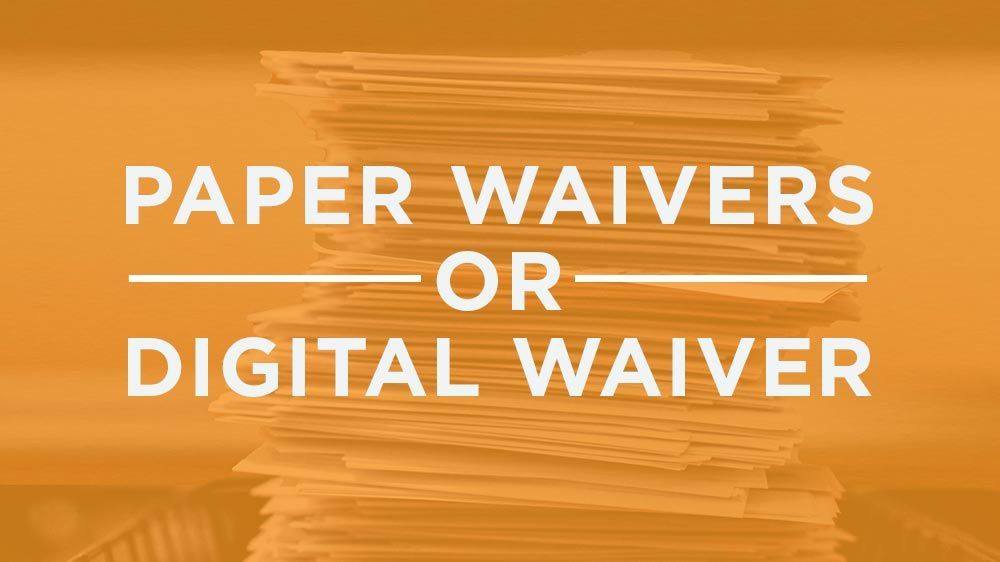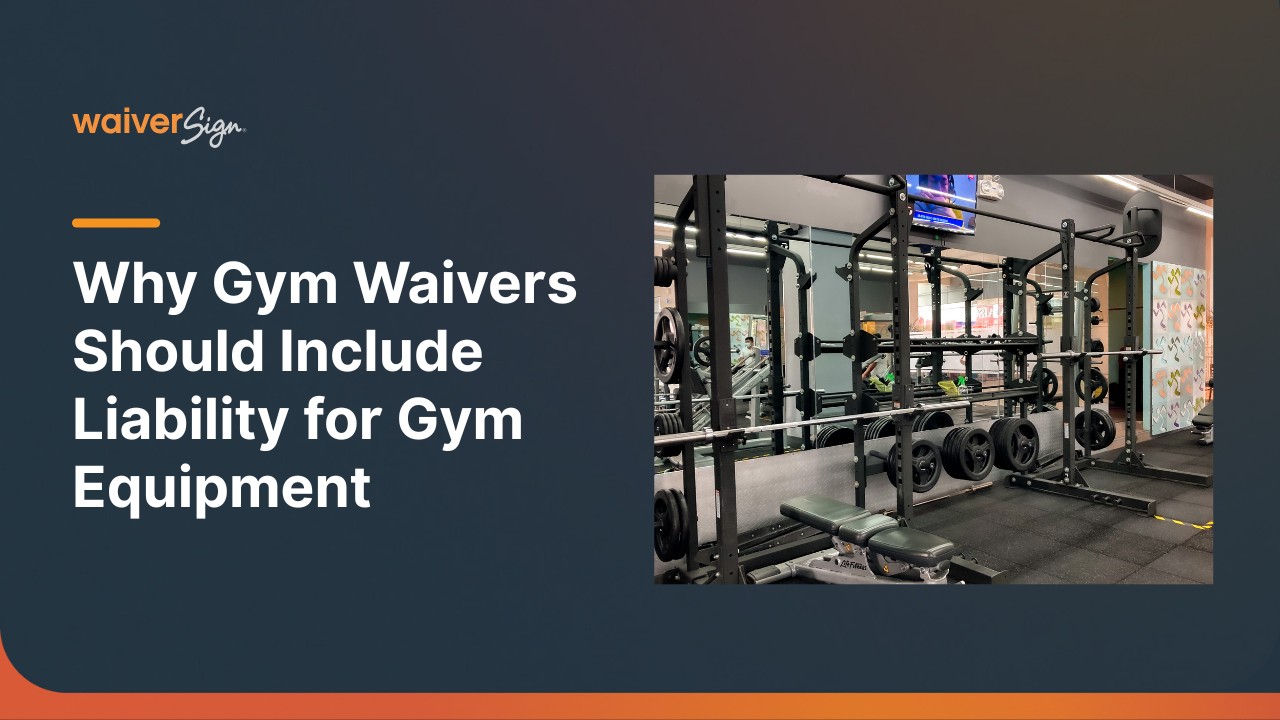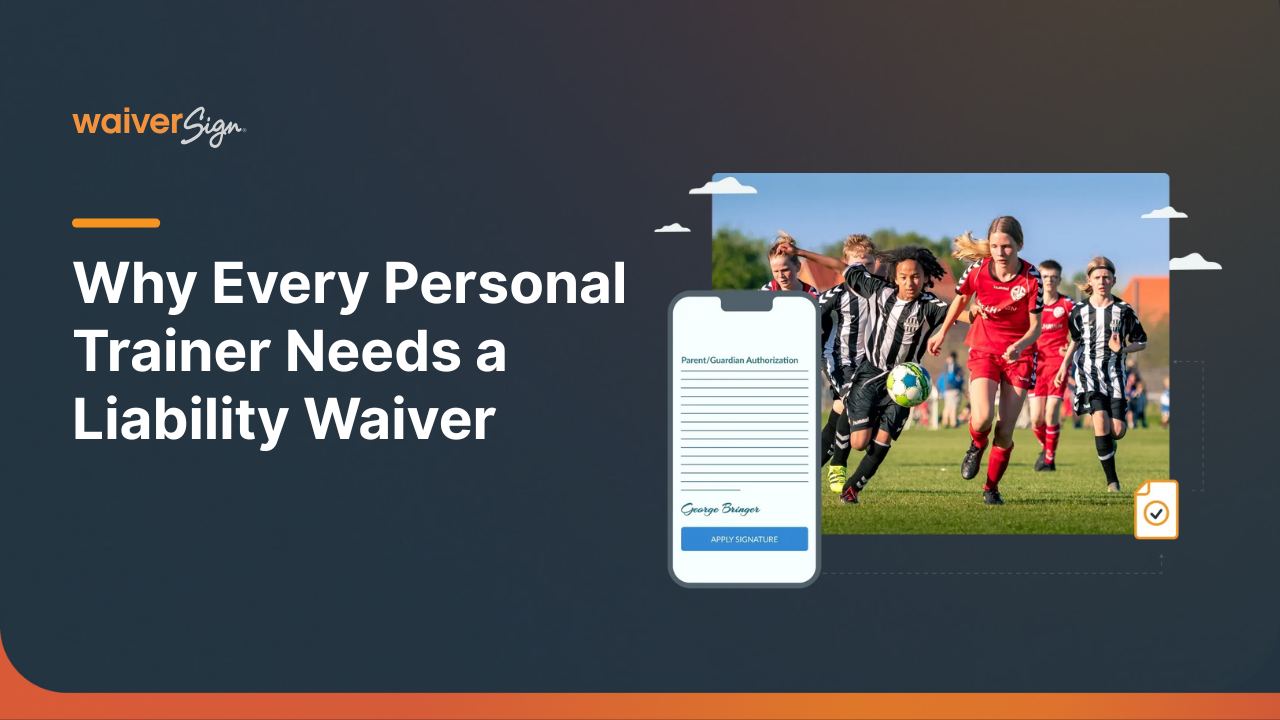Personal Trainer and Gym Waivers
STEPHEN PORRITT

Gyms, Personal Trainers, and Waivers

Stephen Porritt
If you’re a personal trainer or the owner of a gym, you face some unique challenges in your line of work. Your customers and clientele are paying you to participate in activities that, if you were paying them, would fall under OSHA regulations. Working out is like a laundry list of job hazards:
- Repetitive motions
- Lifting heavy objects
- Sustained physical exertion
- Pushing strength and stamina boundaries
- Rapid movements
Throw in a missing wet floor sign, and you've got an exciting day for a safety inspector.
So how do you keep people from getting injured and keep your business from getting sued? It's easier said than done, but there are ways to mitigate the risks both to them, and to you.
How To Manage The Risks
The first step is making things as safe as possible for your clientele. Now, this looks a little different depending on whether you're a gym owner (who provides the location and the equipment) or a personal trainer (who puts the equipment to use), so let’s break it down along those lines.
Managing Risks for a Gym
With a few rare exceptions (like group classes, personal trainer services, and the like), gym staff members aren’t usually in a position to encourage safer workout habits. You won’t be showing them how to deadlift without hurting their back or reminding them to stretch before and after cardio.
What you will be doing is providing a safe environment for your patrons. Just as a manufacturing plant has to take steps to make sure the plant is safe to work in, you have to make sure that the gym is safe to workout in.
The basics are probably pretty obvious:
- Clean up spills quickly, so no one slips
- Keep equipment maintained, so none of it breaks while being used
- Make sure the floor is picked up, so there are no trip hazards
- Make sure things that should be padded are padded
- Make sure the gym is well lit
But some precautions are less obvious:
- Sanitize equipment regularly (especially handles) to curb the spread of disease
- Keep a bodily fluid cleanup kit stocked in case of vomit, urine, or blood
- Keep a first aid kit on hand in case of injuries
Bottom line: if you wouldn't ignore it at home, don't ignore it at your gym.
Managing Risks for a Personal Trainer
Personal trainers effectively have to do the opposite. Since you deal directly with the client as they do the exercises, you have to be a little more, well personal with your efforts to prevent injuries.
The good news is that most of what’s required for that job, you're likely already doing. This includes showing them how to do the exercises properly and correcting mistakes as they go, spotting them when they lift weights, and so on. Really, there's only one thing you need to be especially careful with, and that's how far you push your clients.
There are a lot of factors that impact an individual’s physical abilities—their medical history, their baseline level of activity, their age, their gender, their mood, their sleep habits, even what they've eaten that day. Some people perform better as sprinters, while others do better at sustained exertion. Some do better with increased resistance and weights, while others are less muscular and more flexible.
In other words, each client probably needs a fair amount of evaluation to determine what's too far, and what’s not far enough. You're likely much better equipped to do that than we are. You probably know far more about exercise science than we ever will, but what you might not know is just how easy an injury from overexertion can turn into a business-ending lawsuit.
So what can be done to protect your business legally after you've done all you can to protect your clients physically? And what can gyms do to limit their liability should some yay-hoo start hefting weights around in a very irresponsible fashion?
Simple: make your clients sign liability waivers.

What Is A Liability Waiver?
A liability waiver, sometimes called a "release of liability" or "release form," is a document that outlines the relevant risks involved in a particular endeavor, and asks signers to acknowledge that they know and accept these risks by putting their name on a dotted line.
In other words, it's a document where people say "unless something really weird happens, I 'waive' the right to sue you should something go wrong."
Waivers are pretty handy, and they're used in a variety of industries to cover lots of different kinds of risks. It's used in the adventure travel industry, where zipline and bungee jumping operators have participants sign in case of physical injury. They're used in the racing industry in case a driver crashes. They're used by moving companies in case stuff gets damaged in transit.
Most relevant to our current discussion, they're also used in the fitness industry in case of belligerent barbells, or in case a rowing machine goes rogue.
The basics of waivers are this: they offer businesses a level of protection from liability, and they (if they’re good) are unique to both the business and the activity.
Side note: getting a "good" waiver isn’t as simple as pulling a template off the internet. It requires input from a lawyer, preferably one who’s familiar with the ins and outs of your specific industry. More on this below.
Do Personal Trainers And Gyms Need Waivers?
When you really get down to brass tacks, waivers have a single job: prove to the court that the person who signed it knew and accepted the risks before doing business with you. Whether or not you use waivers depends on whether you want a claim like "I didn't know this could happen" to get any traction in court.
That’s not to say that waivers are foolproof. If a judge determines that there was negligence, that the claim falls outside of the purview of the waiver, or something on those lines, the waiver won't help you. What a waiver can do, though, is keep a common incident (like a twisted ankle or a sprained back) from becoming a major legal problem.
Non-Injury Considerations
Injuries aren't your only concerns, though. There are a few other types of risks that you’ll want protection from, and best practice is to have a separate waiver for each. Let’s take a look at what they are.
WHAT ABOUT HARASSMENT?
For both gyms and personal trainers, there's a lot of opportunities for interactions that can be interpreted as harassment, of one form or another.
For example, at a gym, if an individual feels like they've been insulted or mistreated about their weight, it can quickly become a problem. And you don't just have to worry about your staff—if other patrons are, well, patronizing someone, it’s possible your gym could be held liable for facilitating the environment where the harassment happened.
The same goes for sexual harassment. If a patron is subject to repeated, inappropriate advances from staff or other patrons, it can likewise create some legal trouble for you.
For personal trainers, it gets even worse. If, for example, you're trying to adjust a client’s stance while doing an exercise, and you touch them on their legs or hips in a way they find inappropriate, they might lay a sexual harassment charge at your feet.
Part of the problem here is that people tend to feel a little vulnerable while working out. While there are some who don't feel self-conscious about their bodies while in the gym, plenty of patrons feel the weight of negative body image, low self-esteem, and the more revealing nature of typical workout attire.
As a result, the impact of aggressive or critical language (even if intended to motivate) can be more dramatic. These feelings of vulnerability only amplify the discomfort caused by actions that count as (or could be misconstrued as) sexual harassment. And since this is all dependent upon how the person feels (which is outside your control), you'll want some protection for your business.
Now, waivers aren't really designed to protect against willful offenses (and it wouldn’t be fair to the victim if they were), but they do help mitigate liability for incidents that were unintentional, harmless, or outside your control. In other words, you'll probably want to consider having a waiver with verbiage aimed at addressing these concerns.
WHAT ABOUT COVID?
A relatively recent concern (though it feels like forever by now, doesn't it?) is that of the Coronavirus. Pretty much from the initial outbreak, the virus has been throwing wrenches into business concerns left and right. Now that even gyms are starting to reopen, businesses are forced to face the cargo load of risk that comes with operating during the pandemic, and many are wondering if they need a waiver to cover those risks as a result.
While we certainly recommend a waiver for this purpose, we need to add the caveat that these waivers aren't always effective at protecting businesses. A lot of it depends on where your business is located—laws vary by state and by country, and waivers that fly with one judge may flop with another.
What we're saying is that this is all new legal territory, and courts and lawmakers are still figuring things out. A waiver isn't a guarantee of protection right now, but it's a lot better than nothing. Our advice: talk to a legal expert, and get their help drafting a waiver with COVID-specific language. Then take proper safety precautions, and have people sign your waiver to cover your bases.
WHAT ABOUT INSURANCE?
At this point, a few of you may be wondering "Why do I need waivers when I have insurance?" It’s a good question. After all, why go through all the trouble of putting together waivers if insurance will just cover everything?
Liability waivers and liability insurance have different purposes, though. Gym and personal trainer waivers are intended to prevent legal problems caused by the normal operation of the business. Insurance is designed to help cover the loss incurred by resolving the valid liability concerns of patrons.
Here's a good way to think of it. If a gym patron hurts his back from lifting weights improperly, a previously signed waiver will prevent him from suing the gym for "injuring" him. If, on the other hand, a poorly maintained, out-of-control treadmill speeds up to 60 mph and toss him across the room, insurance will help you pay for his medical bills.
You’re gonna want to have both, is what we’re saying, since lacking either can really cost you.
How Do I Get My Waivers?
This won't take long to explain, but it's a very important question. See, a lot of businesses take the easy way out. They do a Google search for a waiver template, find one that kinda fits, change the name of the business, print it out, and call it good. If that was your plan immediately after finishing this article, we regret to inform you that it's not a very good idea.
Remember when we mentioned that the best waivers are unique to the business and unique to the activity? We weren't kidding. Filing the serial numbers off of somebody else’s template opens up a lot of legal loopholes people can use to sue your business.
If the signer (also called a "releasor") can prove to a judge that your waiver covers things that are irrelevant to your business (like, say, the risk of consuming food contaminated by an allergen, like peanuts), or that there are things it should cover that it doesn't (like the risk of dropping a weight on your foot), the judge can throw the waiver out for being a poor representation of the actual risks involved with the activity.
Once that happens, just about anything is fair game.
Your best bet is to consult with a lawyer, preferably one that knows the fitness industry. Sure, it's a bit of an investment upfront, but having a waiver that's actually tailored to your business puts you in a much safer position, liability-wise. A stock waiver may mitigate your liabilities, but it'll be a very costly mistake if it doesn't.

Does It Have To Be On Paper?
Finally, we have the issue of paper waivers. Paper waivers have a number of really irritating disadvantages, including:
- They take physical space to store (and requires more space as you get new customers)
- You have to print physical copies
- If you run out of copies, you have to go print more in order to get anything done
- Finding information that's on a waiver requires sifting through all of them
- If your waivers aren’t organized properly, the task of finding a waiver becomes much harder
- Waivers that are signed by hand are often a lot harder to read
- Signers can manipulate paper waivers (writing stuff in, crossing stuff out), and this lack of document integrity can really undermine its legitimacy
- There are a lot of opportunities to pass the Coronavirus with all the passing of pens and paper
Any of those sound appealing? We didn’t think so, and we’d like to offer a solution. Digital waivers are a thing now, allowing people to sign electronically, even from the comfort of their own home. It’s contactless, it’s environmentally friendly (since you’re not killing so many trees), and it makes it a lot easier to track things like demographic data.
Now, there are a number of brands on the market that offer this solution. Each one has it’s pros and cons, and if we told you that WaiverSign (which is our solution) worked for everybody our pants would catch fire (because, you know, we'd be...liar liars).
But we do have a solid solution, and if we've at all convinced you of the importance of waivers, then we invite you to start your search for a solution with us. And if the features of our system don’t exactly line up with your needs, we can help you find a digital waiver system that does.
So get in touch with us, and let’s talk about your "risky business." We'd be happy to help you put waivers to work for you.

See If WaiverSign Works For You
Don't wait to make the next step in streamlining your business.





























